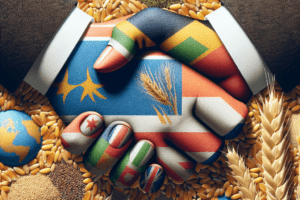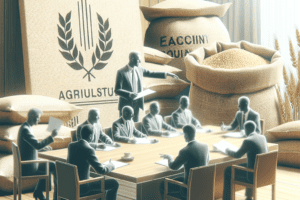Key grain trading routes around the world play a crucial role in the global economy, facilitating the movement of essential food commodities that sustain populations and drive agricultural markets. Understanding these routes is vital for stakeholders in the agricultural sector, including farmers, traders, and policymakers, as they navigate the complexities of grain supply and demand. This article explores the major grain trading routes, their significance, and the factors influencing their dynamics.
Major Grain Trading Regions
The world is divided into several key regions that are pivotal in grain production and trade. Each region has its unique characteristics, advantages, and challenges that shape its role in the global grain market.
North America
North America, particularly the United States and Canada, is one of the largest grain-producing regions in the world. The Midwest, often referred to as the „Corn Belt,” is renowned for its vast fields of corn and soybeans. The Great Plains also contribute significantly to wheat production. Major trading routes in this region include:
- Mississippi River: This river serves as a vital artery for transporting grains from the interior of the United States to the Gulf of Mexico, where they can be shipped to international markets.
- Railroads: Extensive rail networks connect grain-producing states to major ports, facilitating efficient transport to both domestic and international markets.
- Great Lakes: The Great Lakes provide a navigable route for shipping grains to Canada and other parts of the United States.
South America
South America, particularly Brazil and Argentina, has emerged as a significant player in the global grain market, especially in soybean and corn production. The region’s trading routes are characterized by:
- Paraná River: This river is crucial for transporting grains from the interior of Brazil to ports on the Atlantic coast.
- Road Networks: Improved road infrastructure has enhanced the ability to move grains from farms to processing facilities and ports.
- Port Facilities: Major ports like Santos in Brazil and Rosario in Argentina are key export hubs for grains.
Europe
Europe is another significant grain-producing region, with countries like France, Germany, and Ukraine leading in wheat production. The trading routes in Europe are influenced by:
- Danube River: This river serves as a critical transport route for grains from Eastern Europe to Western markets.
- Rail and Road Systems: Extensive rail and road networks facilitate the movement of grains across countries, enhancing trade efficiency.
- European Union Policies: Trade regulations and subsidies within the EU impact grain production and trade dynamics.
Asia
Asia, particularly countries like China and India, has a growing demand for grains due to increasing populations and changing dietary preferences. The trading routes in this region are shaped by:
- Yangtze River: This river is vital for transporting grains within China, connecting agricultural regions to major cities.
- Infrastructure Development: Investments in infrastructure, such as roads and ports, are enhancing the efficiency of grain transport.
- Regional Trade Agreements: Agreements among Asian countries can facilitate grain trade and reduce tariffs.
Factors Influencing Grain Trade Routes
Several factors influence the dynamics of grain trading routes, affecting how grains are produced, transported, and traded globally. Understanding these factors is essential for stakeholders in the agricultural sector.
Climate and Weather Patterns
Climate plays a significant role in grain production and trade. Variability in weather patterns, such as droughts or excessive rainfall, can impact crop yields and, consequently, the availability of grains for trade. For instance:
- Droughts: Prolonged dry spells can lead to reduced yields, particularly in regions heavily reliant on rain-fed agriculture.
- Flooding: Excessive rainfall can damage crops and disrupt transportation routes, affecting the timely movement of grains.
- Climate Change: Long-term changes in climate patterns can alter the suitability of regions for grain production, shifting trade routes over time.
Technological Advancements
Technological innovations in agriculture and transportation have significantly impacted grain trade routes. These advancements include:
- Precision Agriculture: Technologies such as GPS and drones enable farmers to optimize crop yields, increasing the volume of grains available for trade.
- Improved Transportation: Innovations in shipping and logistics, including containerization and automated systems, enhance the efficiency of grain transport.
- Data Analytics: The use of data analytics helps traders make informed decisions regarding market trends and pricing, influencing trade routes.
Global Economic Trends
The global economy significantly influences grain trade routes. Economic factors that impact grain trade include:
- Supply and Demand: Fluctuations in global demand for grains, driven by population growth and changing dietary preferences, can shift trade routes.
- Trade Policies: Tariffs, quotas, and trade agreements can either facilitate or hinder grain trade, affecting the routes used.
- Currency Fluctuations: Changes in currency values can impact the competitiveness of grain exports, influencing trade patterns.
Political Stability
Political factors also play a crucial role in shaping grain trade routes. Stability in producing countries is essential for maintaining consistent grain supply chains. Key considerations include:
- Government Policies: Supportive agricultural policies can enhance production and trade, while restrictive policies can hinder growth.
- Conflict and Instability: Regions experiencing conflict may see disruptions in grain production and trade, leading to shifts in routes.
- International Relations: Diplomatic relations between countries can facilitate or obstruct grain trade, impacting the routes used.
Conclusion
Key grain trading routes around the world are essential for ensuring food security and supporting the global economy. Understanding the major regions involved in grain production, the factors influencing trade routes, and the challenges faced by stakeholders is crucial for navigating the complexities of the grain market. As the world continues to evolve, so too will the dynamics of grain trade, necessitating ongoing adaptation and innovation within the agricultural sector.













